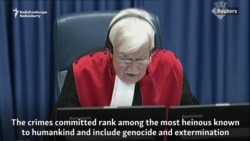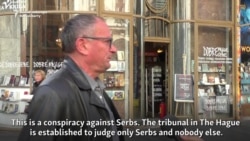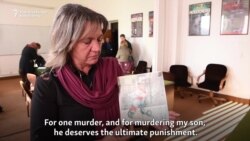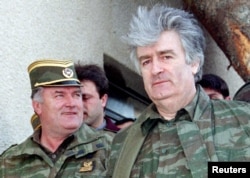The International Criminal Tribunal for the former Yugoslavia (ICTY), set up by the UN in 1993 to deal with war crimes committed during the Balkan conflicts of the 1990s, is nearing its end. Whether it can claim "mission accomplished" when it formally closes its doors on December 31 remains a question, however.
For many in the region, The Hague tribunal has been a great insult; for others a disappointment.
In Serbia and Republika Srpska the state media and nationalist politicians have successfully promoted a narrative of the ICTY as essentially "anti-Serb" and part of a conspiracy to hold only Serbs responsible for crimes while minimizing the guilt of others.
Meanwhile, most Croats indicted by the tribunal are still celebrated as heroes of the Homeland War, and their prosecution is seen as a travesty.
The dominant feeling in Bosnia-Herzegovina, on the other hand, is one of disappointment. There had been, perhaps, an unrealistic expectation that the tribunal would somehow be able to bring back prewar Bosnia; that it would rescind the new reality of an ethnically divided country created by the war.
In the end, the tribunal had established beyond doubt that the Bosnian Muslims were by far the war's biggest victims, but no court could return Bosnia to its prewar state.
Yet with all its ups and downs, the ICTY has been a cornerstone in the fight against impunity for the crimes committed in the series of wars in the former Yugoslavia (1991-99). Those most responsible did eventually end up in the detention unit of The Hague tribunal -- in some cases after years spent in hiding -- and were by most accounts given fair trials.
The credibility of the ICTY rests, above all, on the trials of two individuals in its courtrooms -- Radovan Karadzic and Ratko Mladic, the supreme political and military leaders of the Bosnian Serbs in the war (1992-95). They have been accused -- and convicted -- of the gravest crimes that have come under the purview of the court, and which had by far the largest number of victims. The successful prosecutions of Karadzic and Mladic are undoubtedly a triumph for international justice.
Sarajevo Siege
Apart from the genocide in Srebrenica -- the massacre of more than 8,000 unarmed men and boys -- Mladic was held primarily responsible for the bombardment of Sarajevo. The city was under siege for 1,425 days; its citizens deprived of the necessities of life, such as water and electricity, and allowed only meager rations of humanitarian aid. More than 10,000 civilians were killed, including at least 1,000 children. Shells fired from the surrounding hills landed on playgrounds and marketplaces, murdering indiscriminately.
In one infamous video, Mladic was recorded issuing an order to his artillery to "hit Velesici, not many Serbs there!" Velesici was a Sarajevo suburb, ethnically mixed like the rest of the city. Mladic's chilling order revealed the real purpose of the violence, which was to divide people along ethnic lines, and to "cleanse" territory of non-Serbs.
Interestingly, in the course of their parallel trials Mladic refused to be a witness for the defense of Radovan Karadzic. He did not want to hurt his own case. Karadzic was eventually sentenced to 40 years in prison, although both the defense and the prosecution have appealed the sentence -- in the latter case demanding life imprisonment. The final decision will be made by the Mechanism for International Criminal Tribunals (MICT), which will take over remaining ICTY cases and serve as the repository of its judicial records.
The first president of the tribunal, Antonio Cassese, believed that its great achievement was the individualization of guilt. He was convinced that holding specific individuals responsible would prevent the assigning of collective blame -- to entire nations -- for the crimes committed.
That expectation has been largely disappointed. Two decades later, during a visit to Sarajevo in June 2017 to announce the successful conclusion of the court's work, ICTY President Carmel Agius acknowledged that reconciliation was not part of The Hague tribunal's brief.
"We are not offering reconciliation, because it has not been the mandate of this court to do it. We have not dealt with it at all. All the citizens in the countries in the region have the responsibility for reconciliation," he said.
"We are closing the door, but we are giving you a large collection of determined facts. We are giving you the truth about what happened," Agius said.
That, however, is no small achievement, and there have been many firsts in international humanitarian justice along the way.
Epistemological Earthquake
The ICTY was the first international criminal tribunal since the post-World War II Nuremberg and Tokyo tribunals, and the first tribunal established under Chapter VII of the UN charter. It has issued more indictments than any other international criminal court, and has brought 161 individuals to justice. Its most important achievement is the sheer volume of documents its trials have generated, which together constitute nearly all the pieces of the puzzle that is the destruction of Yugoslavia.
While few in either Belgrade or Zagreb will publicly lament the tribunal's closure, it presents them with a dilemma. The Hague -- and its perceived biases and injustices -- has served nationalists in both Serbia and Croatia as a means of keeping the wounds of the war open, and putting off reconciliation. Yet it will no longer be possible to invoke the tribunal and its alleged shortcomings as an obstacle to a lasting rapprochement, writes Refik Hodzic in a piece published on the respected Serbian portal Pescanik titled The Years The War Criminals Devoured (a play on the title of the prison memoirs of the Serbian writer Borislav Pekic, The Years The Locusts Devoured).
"The Hague archives are a treasure trove, they contain the truth about us, the truth about the tragic collapse of a community that experienced an epistemological earthquake and swapped the truth for myth, institutions for false prophets," writes Hodzic.










